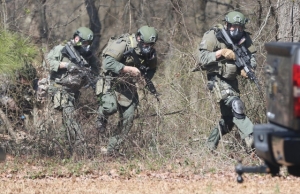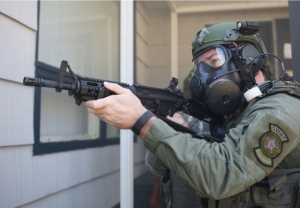Officers participate in simulation exercise
By John Joyce
Published in News on February 18, 2016 1:46 PM

News-Argus/CASEY MOZINGO
Members of the Wayne County Sheriff's Office SWAT team emerge from the woods to seek cover behind a truck during a training exercise Wednesday. The scenario gave officers training with hostage negotiation, a barricaded suspect and a wounded officer.

News-Argus/CASEY MOZINGO
A member of the SWAT team watches a window as the team makes entry into a house that has been filled with smoke during a training exercise.

News-Argus/STEVE HERRING
A member of the Wayne County Sheriff's Office SWAT team approaches a house during training Wednesday.
The Wayne County Sheriff's Office SWAT team conducted a training exercise at the Wayne County Law Enforcement Association club house off of Old Mount Olive Highway Wednesday.
The exercise began around 8 a.m. and lasted through lunchtime.
It was part of the sheriff's office quarterly training program designed to improve its efficiency when dealing with potential true-to-life scenarios.
"This training exercise consisted of a downed officer rescue, a hostage rescue and a barricaded suspect," SWAT team Commander Sgt. Chris Peedin said.
Peedin said the scenario his unit responded to started with a simulated domestic dispute where the husband lost control.
"The wife left, deputies responded and one of them gets shot," Peedin said about the premise of the exercise scenario.
From there in the simulation, law enforcement began negotiations, urging the "suspect" to release his two remaining "hostages" before refusing surrender. SWAT team members then simulated launching gas canisters into the house allowing a tactical team to make entry and subdue the suspect.
Peedin said the situation reflected circumstances law enforcement officers encounter every day that do not normally escalate to such a large event. But when they do, it can happen quickly.
"One thing leads to another and the escalation is very easy," he said.
Officers do not often know the mind state of the subjects they might encounter before they are on scene and engaged with them, he said.
"He might have an extensive criminal history. He might know he is facing a long prison term based on what he's done and be thinking, 'I'm not going down without a fight,'" Peedin said. "Or he might be mentally unstable, not in his right mind or he is somehow intoxicated."
The SWAT team trains for a multitude of scenarios. The biggest reason is that no one from the incident -- commander on down -- is incapable of missing something.
"You want to make sure you don't forget the small things," he said. "It's the little things that are important."
Peedin acted as incident commander Wednesday while assistant SWAT team commander Sgt. Matt Miller stepped into Peedin's normal role as SWAT team commander. Both men took the opportunity to get comfortable in roles they might have to fill one day in a real world scenario. Such was the case during the on-campus shooting at Wayne Community College in April 2015.
"You had one person who was the incident commander over the whole scene, then you had another commander over part of it, and the SWAT team was sort of able to break off and do what it needed to do on its own," he said.
Following the training exercise, the entire team -- the SWAT team, the negotiators, the snipers and the role players, including the hostages and the hostage taker -- assembled back at the club house for a debriefing.
"We will go up there, sit down and debrief every step," Peedin said. "From our initial response time, how long it took us to get on scene, every step, and see what we need to do to improve."
